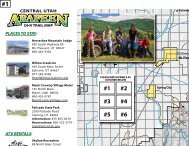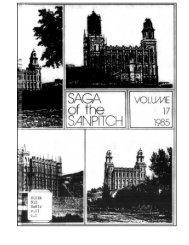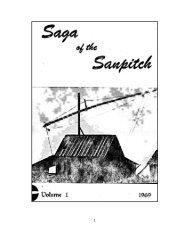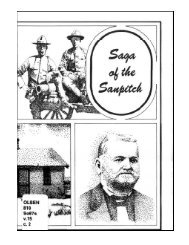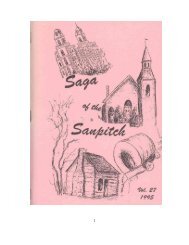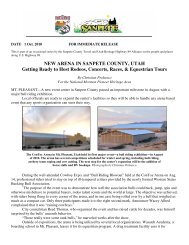Saga of the Sanpitch Volume 13, 1981 - Sanpete County
Saga of the Sanpitch Volume 13, 1981 - Sanpete County
Saga of the Sanpitch Volume 13, 1981 - Sanpete County
- TAGS
- saga
- sanpitch
- volume
- sanpete
- sanpete.com
You also want an ePaper? Increase the reach of your titles
YUMPU automatically turns print PDFs into web optimized ePapers that Google loves.
The Academy was designed to teach what was essential to <strong>the</strong>ir pioneer existence, to make up for <strong>the</strong><br />
absence <strong>of</strong> education in many <strong>of</strong> <strong>the</strong>ir lives, and to build a foundation for fur<strong>the</strong>r education for <strong>the</strong> young. It<br />
began "upstairs in <strong>the</strong> building now part <strong>of</strong> <strong>the</strong> Hermansen Mill at Main and First North Street...The school<br />
room... was lighted by hanging coal-oil lamps." 7 It was one room with a stage where shows, dances and<br />
programs were held. The stage and <strong>the</strong> large room were used as classrooms, separated by a canvas curtain.<br />
Two stoves heated <strong>the</strong> room and <strong>the</strong> stage. 8<br />
Hunger for learning soon made more space necessary. In 1896 <strong>the</strong> one-room North Ward School House<br />
was secured.* After it was repaired, new school furniture was provided at a cost <strong>of</strong> $300, 9 raised by donations.<br />
Later ano<strong>the</strong>r room was added to serve as an <strong>of</strong>fice and a classroom when necessary. Still students were<br />
turned away. When <strong>the</strong> Commercial Department was begun, it was housed on <strong>the</strong> second floor <strong>of</strong> <strong>the</strong><br />
Progress Market (west side <strong>of</strong> Main Street between Center Street and First North); <strong>the</strong> dressmaking<br />
department was on <strong>the</strong> second floor over <strong>the</strong> Ephraim Market (<strong>the</strong> east side <strong>of</strong> Main Street between Center<br />
Street and First South). 10<br />
They had found ready-made space, scattered, but usable; but finances were always a critical problem.<br />
From 1888 to 1900 <strong>the</strong> Academy was financed by tuition, assessments, and donations. Tuition in 1888 was so<br />
low it seems startling today: Preparatory Department, per term $4.00; Intermediate Department, per term<br />
$6.00. 11 During 1895» tuition served as <strong>the</strong> sole source <strong>of</strong> revenue. The five teachers willingly responded,<br />
receiving only <strong>the</strong> little tuition paid by students. Karl G. Maeser, Church Commissioner <strong>of</strong> Education, said <strong>the</strong>ir<br />
service would be credited to <strong>the</strong> teachers as a mission. 12<br />
Again in 1898 <strong>the</strong> Church made no appropriation; consequently, teachers left for o<strong>the</strong>r positions.<br />
Noyes, determined <strong>the</strong> school would not close, hired three 1898 graduates from <strong>the</strong> Academy to teach for a<br />
pittance—William G. Barton and Thomas A. Beal (Henry Beal's son). Barton's total salary for three years was<br />
$1,200. His training was less than a high school education! l3 Interesting entries from Noyes' Diary show <strong>the</strong><br />
precarious financial condition <strong>the</strong>y were in: "Through an oversight <strong>the</strong> General Church Board has not made an<br />
appropriation for our Academy," he wrote in 1898. "Teachers received only part <strong>of</strong> <strong>the</strong>ir pay." They sold <strong>the</strong><br />
Academy's piano to pay John Johnson (a teacher) so he "might meet some <strong>of</strong> his *Later it was called <strong>the</strong> North<br />
Ward Chapel, pressing obligations." 14 The piano had been purchased earlier that year with proceeds from a<br />
concert by H. E. Giles and an opera he produced. 15 in 1900, Noyes "secured a loan <strong>of</strong> $150 for M. E.<br />
Christopherson. He will purchase a piano for <strong>the</strong> amount and for <strong>the</strong> favor will allow <strong>the</strong> Academy <strong>the</strong> free use<br />
<strong>of</strong> <strong>the</strong> instrument this year..." l6 Ano<strong>the</strong>r time when <strong>the</strong> school was about to be closed for lack <strong>of</strong> funds, E. C.<br />
Willardson bought one <strong>of</strong> <strong>the</strong> school's pianos for $600, and <strong>the</strong> school was able to carry on. 17 Custodial work<br />
became part <strong>of</strong> <strong>the</strong> educational program. "The financial condition <strong>of</strong> <strong>the</strong> Academy will not justify employing<br />
Bro<strong>the</strong>r Larson (<strong>the</strong> janitor) any longer," wrote Noyes. "I will have to do most <strong>of</strong> <strong>the</strong> work. Bro<strong>the</strong>r T. A. Beal<br />
will make fires in <strong>the</strong> Business Department." 18 According to Fannie Thompson, <strong>the</strong> students helped: "Our<br />
physical education consisted <strong>of</strong> doing janitorial work. Two girls remained after school each night and did <strong>the</strong><br />
sweeping and dusting... The boys hauled <strong>the</strong> wood from <strong>the</strong> mountains, sawed and cut it, which was <strong>the</strong> only<br />
fuel <strong>the</strong>n used, made <strong>the</strong> fires and kept <strong>the</strong>m replenished, took down and cleaned <strong>the</strong> stove pipes when<br />
necessary, and helped <strong>the</strong> girls when <strong>the</strong>ir services were needed in moving benches." 19<br />
In spite <strong>of</strong> <strong>the</strong>ir financial difficulties in <strong>the</strong> bleak year <strong>of</strong> 1898 <strong>the</strong>y had <strong>the</strong> courage and foresight to<br />
plan for a new building largely financed by assessments and donations <strong>of</strong> money, labor and materials. At a<br />
meeting on January 21, 1899, "<strong>the</strong> reports <strong>of</strong> <strong>the</strong> financial canvassing committee were read. The people <strong>of</strong><br />
Ephraim have subscribed $7,400 for <strong>the</strong> erection <strong>of</strong> <strong>the</strong> New Academy ." 20 The first contribution given was $45<br />
by <strong>the</strong> students <strong>the</strong>mselves .21 On Sunday, March 24, 1901, President Beal suggested that <strong>the</strong> sisters <strong>of</strong> <strong>the</strong><br />
North and <strong>the</strong> South Stakes* give <strong>the</strong> Sunday eggs to <strong>the</strong> Academy. The story has it that <strong>the</strong> hens put forth<br />
special effort on <strong>the</strong>se days. 22 in <strong>the</strong> nor<strong>the</strong>rn Stake, <strong>the</strong> deacons collected weekly nickel funds—five cents<br />
from each member <strong>of</strong> every family that could possibly pay. 23<br />
56



